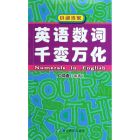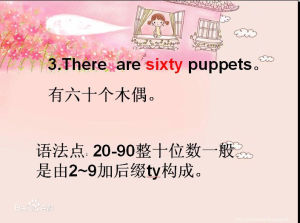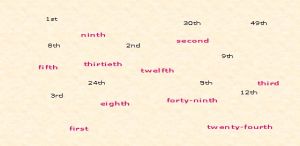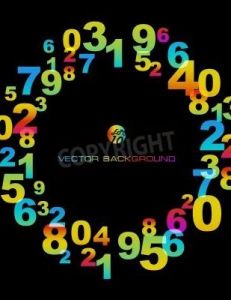基本解釋
數詞是用來表示事物的數目大小和順序先後的詞。

數詞
基數詞
 數詞舉例
數詞舉例2)基數詞一般是單數形式,但下列情況,常用複數:
a. 與of 短語連用,表示概數,不能與具體數目連 用,如scores of people 指許多人;
b. 在一些表示"一排"或"一組"的詞組裡;
如:They arrived in twos and threes. 他們三三兩兩的到達了。
c. 表示"幾十歲":dozens of ages;
d. 表示"年代",用 in the 數詞複數;
e. 在乘法運算的一種表示法裡,如:3 x 5 = 15 Three fives is (are) fifteen.
部分基數詞
1 one, 2 two, 3 three, 4 four, 5 five, 6 six, 7 seven, 8 eight, 9 nine, 10 ten,
11 eleven, 12 twelve, 13 thirteen, 14 fourteen, 15 fifteen,16 sixteen, 17 seventeen, 18 eighteen, 19 nineteen, 20 twenty, 30 thirty, 40 forty, 50 fifty, 60 sixty, 70 seventy,80 eighty, 90 ninety,100 a hundred,1,000 a thousand,1,000,000 a million,1,000,000,000 a billion.
基數詞 1-12 是獨立單詞,需逐個記憶。
基數詞13-19是個位數詞的詞幹後加-teen構成。其中 thirteen, fifteen, eighteen, 變化不規則。
基數詞 20-90 是在十位數詞後面加 -ty 構成。
基數詞 21-99 是在十位數詞後面加上個位數詞合成,中間加上連字元 " ━ " 。 例如: 21 twenty ━ one 95 ninety ━ five
基數詞三位以上的數詞, 在百位和十位之間,一般要用連詞"and "。
例如: 132 one hundred and thirty ━ two.
1340 one thousand three hundred and forty .
表示"萬"的詞英語中沒有.如1萬可用10千來表示。 ten thousand. 30萬可用 three hundred thousand 來表示。
基數詞注意事項
(1)十位數於個位數之間通常用連字符號“-”,一百以上的數詞通常在百位與十位之間加and,沒有十位數時百位數與個位數之間通常也要加and,例如 231 two hundred and thirty-one,509 five hundred and nine,1465a/one thousand,four hundred and sixty-five
(2)用阿拉伯數字書寫千以上的數目時,要由右向左每三位數間由一個空格。第一個空格前為thousand;第二個空格前為million;第三個空格前為thousand million(英)或billion(美)。
英語中沒有萬,十萬,千萬,億這樣的單位數詞,故每兩個空格間的三位數都被看作“十位數或百位數的千”或“十位數或百位數的百萬”。例如 56 000 fifty-six thousand 600 000 000 six hundred million
(3)dozen,score,hundred,thousand,million等數詞前面有基數詞或某些表示數量的形容詞時,不加-s。例如a few hundred meters 幾百米 several million people 數百萬人 two thousand teachers 兩千位老師,但如表示“幾百”“幾千”“幾百萬”等籠統的數目時,則套用-s of構成短語。如:hundreds of books 幾百本書 thousands of workers 幾千個工人
(4)表示一百,一千,一百萬時需加上one或不定代詞a。如:1000 a thousand 1031 a thousand and thirty-one 1100 one thousand ,one hundred 1498 one thousand,four hundred and ninety-eight 比較數字的開頭多用不定代詞a(見前兩例),但在一個有百位數的數目前或在一個數目中間,則要用one(見後兩例)。
基數詞的位置
(1)位於another,all之後,如:Can you have another two cakes? 你還能吃2塊蛋糕嗎? The boy lost all the five pencils last week.這孩子上周把5枝鉛筆全丟了。
(2)位於such和more之前,如:I can finish reading two such books in two days.兩天裡我能讀完這樣的兩本書。Please give me one more apple to eat.請再給我一個蘋果吃。
(3)可置於last,next,other之前或之後,如:His last two books are written in English.他的後兩本書是用英語寫的。
巧記基數詞
基數詞不難記,找清規律很容易,十二以內詞名異;
十三數到十九數去,後加-teen莫忘記。
二十 三十至九十,整十之後有-ty;
要說“幾十幾”,中間“-”號別丟棄,
hundred是“一百”,請你記住莫大意。
序數詞
列表
 序數詞舉例
序數詞舉例序數詞的縮寫形式: first---1st second---2nd thirty-first---31st
1.first (1st)
2. second (2nd)
3. third (3rd)
4.fourth (4th)
5.fifth (5th)
6.sixth (6th)
7. seventh (7th)
8. eighth (8th)
9. ninth (9th)
10. tenth (10th)
11. eleventh (11th)
12. twelfth (12th)
13. thirteenth (13th)
14. fourteenth (14th)
15.fifteenfifteenth (15th)
16.sixteensixteenth (16th)
17.seventeen seventeenth (17th)
18.eighteen eighteenth (18th)
19.nineteen nineteenth (19th)
20.twenty twentieth (20th)
21.twenty-one twenty-fist (21st)
22.twenty-two twenty-second (22nd)
30.thirty thirtieth(30th)
40.forty fortieth (40th)
50.fifty fiftieth (50th)
60.sixty sixtieth (60th)
70.seventyseventieth (7th)
80.eighty eightieth (80th)
90.ninety ninetieth (90th)
100.a/one hundred one-hundredth (100th)
101.one hundred and one one hundred and first (101st)
1000.a/one thousand one thousandth (1000th)
1,000,000.a/one million one millionth (1,000,000th)
除了first, second, third以及和它們一起組成的高位序數詞以外,序數詞的構成方法是在 相應的基數詞之後加-th,但要注意fifth, eighth, twelfth等不規則拼法。twenty, thirty等在變 為序數詞時,要把y變成i, 再加-eth。
口訣
一,二,三要全變;(one-first;two-second;three-third)
其餘都加th,th里有例外,8去t,(eight-eighth)9去e(nine-ninth)
字母f代ve(five-fifth;twelve-twelfth);ty變成tie(twenty-twentieth)
若要變化幾十幾,只變個位就可以(twenty-one-twenty-first)
用法
一、整數的表示方法
1.表示二十以上的十位數,要在個位數與十位數之間加連字元號。表示百位數,要在
百位數與十位數之間(無十位數,則在百位數和個位數之間)加and。在美國英語中,and往
往省去。如:
68 ─ sixty-eight
156 ─ one/a hundred (and) fifty-six
602 ─ six hundred (and) two
2.書寫千位數以上的阿拉伯數字,從後往前每隔三位用一分節號,如:
1,000 = one/a thousand
10,000 = ten thousand
100,000 = one/a hundred thousand
1,000,000 = one/a million
在一些科技文章中,千位以上的數不使用分節號,而用一個空白字元表示分節,如:56
112 482。
3.hundred, thousand, million等詞前面有具體數字或several修飾時,不加-s。如:
The magazine has two million readers.
不與數詞或several連用,可以複數形式出現,表示“數以百計”、“成千上萬”等。如:
Mr. Smith has donated (捐贈) hundreds of books to the school. (數以百計)
二、倍數的表達方法
1.用…times表示。如:
My room is three times as large as yours.
我的房間是你的三倍大小。
如果表示“是……兩倍數”,一般用twice。如:
My room is twice as large as yours.
我的房間是你的兩倍大小。
2.用-fold表示。如:
The value of the stock has increased two-fold since we bought it .
股票的價值已漲至我們購買時候的兩倍。
3.用-%表示。如:
The collection of our school library is 200% up compared with 1998.
我們學校圖書館藏書量與1998年相比增長了一倍.
4.用double(翻一番),triple(三倍於),again等詞表示倍數。如:
This coat cost me as much again as the coat I have just bought.
這件外套和我剛買的那件外套的價格一樣。
三、分數、小數和百分數表示法
1.分數的分子以基數詞表示,分母以序數詞表示,當分子大於1時,序數詞要用複數, 其寫法與讀法如下:
1/2 — a/one half
1/3 — a/one third
1/4 — a/one fourth; a/one quarter
2/5 — two fifths
2.小數是以基數詞加小數點表示,小數點前面的數按基數詞的規則讀,小數點後面的數按個位基數詞依次讀出,如: 0.5 — zero point five
0.006 — zero point zero zero six
0.257 — zero point two Five seveN
148.06 — a/one hundred and forty-eight point zero six
其中zero可替換為naught或讀作oh。
3.百分數是由基數詞或小數加百分號組成,百分號(%)讀作per cent,如:
0.6% — zero point six per cent
5% — five per cent
100% — one hundred per cent
12.34% — twelve point three four per cent
四、時間的表示法
1.十二小時計時制
使用十二小時計時制,為了避免午前、午後時刻的混淆,有時要在時刻後面加a.m. /am
或p.m. /pm以示區別。如:10:11 a.m.、 6:20 p.m.。
2.二十四小時計時制
用於軍事或國際時刻的二十四小時制,書寫時用四位數字。“時”和“分”之間可用“:”,
也可省略。如:0000(零時)、1300(十三時)、18:30(十八時三十分)。
年、月、日的表示法
五、年份的表示法
1.年份通常用阿拉伯數字表示,用基數詞讀。公元前用B.C.表示,公元用A.D.表示,讀
其字母音。A.D.
一般用於公元1年到公元999年之間的年份。如:
公元前502年寫作502 B.C.
公元429年寫作429 A.D.
公元1000年寫作1000。
2.年代表示法
年代用年份的阿拉伯數字加-’s或-s表示。如:
十七世紀二十年代寫作1620’s或1620s。
初期、中期、末期分別用early,mid-和late表示。如:
三十年代初期寫作the early thirties。
三十年代中期寫作the mid-thirties。
三十年代末期寫作the late thirties。
二十世紀五十年代初期寫作the early 1950’s;
中期寫作the mid-1950’s;
末期寫作the late 1950’s。
3.月、日的表示法
表示月、日既可以先寫“月”再寫“日”,也可先寫“日”再寫“月”。如:
9月1日寫作September 1,讀作September the first;或1 September,讀作the first of
September。
表示年、月、日,要將年份放在最後,用逗號和月、日隔開,如1998年7月1日寫作
July 1, 1998或1 July, 1998。
在非正式文體中,年、月、日可以全用數字表示。如:
1996年6月10日寫作6,10,1996或10,6,1996。為避免誤解,宜將月份拼出。
不定數目的表示法
六、“大約”的表示法
(1) about, approximately, around, more or less, roughly, some等詞 數詞,或數詞 more or less, or so, or thereabouts等詞。如:
about / some 1,000 books
2,000 seats more or less
approximately 86 miles
sixty or so pages / sixty pages or so / sixty pages or thereabouts
somewhere也可表示“大約”,如somewhere about 300 people。
(2) 基數詞或阿拉伯數字末尾 -ish。如:
I’ll come (at) tenish tomorrow morning. (十點左右)
She is 40ish. (五十歲左右)
(3) 十位數 -s。如:
He is in his teens.
She is in her forties.
七、“多於……”、“大於……”表示法
(1) above, more than, over等 數詞。如:
above 90 Yuan
students over 45
(2) 數詞 odd。如:
20-odd chairs
3.“少於……”、“不到……”表示法
almost, below, less than, under等 數詞。如:
almost ten years old
less than a minute
under two hours
八、數詞的特殊用法
1.a 序數詞(再一……,又一……)和the 序數詞(第……)
I’ll see the movie a second time.(再看一次)
This is the second time I have seen the film. (第二次)
2. 具有誇張含義的成語中的數詞並不表示具體的數。如:
The glass broke into a hundred pieces.(摔得粉碎)
Once bitten, twice shy.(一次被咬,下次膽小)
A thousand thanks to you.(萬分感謝) 形容詞是指用來修飾名詞的詞。
形容詞最典型的位置是位於限定詞與名詞之間,在這種位置上的形容詞被稱為定語,如:
all those three old trees.
所有那三棵老樹。
形容詞的第二個重要位置是在be或其它系動詞之後,作主語補語用,如: The door is close. 門是關的。
作主語補語的形容詞還可以作賓主補語,如:He pushed the door open. 他把門推開了。
形容詞除了作定語、主語補語和賓語補語外,還可以作狀語,如:ark brown hair .深褐色的頭髮 。
此外,某些形容詞在某些條件下具有名詞的句法作用,作主語或賓語。許多形容詞沒有形式特徵,但有些形容詞具有形式特徵,形容詞的典型詞尾包括:
-able / -ible, 如:comfortable, contemptible
-ish / -like, 如:childish, childlike
-ful / -less, 如:powerful, powerless
-ous, 如:delicious, anxious
-y, 如:pretty, dirty
基數詞和序數詞的用法
1. 基數詞的用法
(1) 作定語。如:
There are only three boys in the class. 班上只有3名男生。
Ten people will come to the party. 十個人要來參加聚會。
(2) 作主語。如:
It is said that thirteen is an unlucky number. 據說13是個不吉利的數字。
Three of them will play football. 他們中有三人要去踢足球。
(3) 作賓語。如:
It is worth three hundred. 這件東西值300。
The city has a population of three million. 這個城市有三百萬人口。
(4) 作表語。如:
I am eighteen. 我18歲。
Two and two is four. 二加二等於四。
(5) 作同位語。如:
Are you two coming? 你們倆來嗎?
They ten will go abroad. 他們十個人將出國。
2. 序數詞表示法
(1) 有時序數詞前面可加不定冠詞來表示“再一”,“又一”這樣的意思。如:
We'll have to do it again. 我們得重做一次。
Shall I ask him a third time? 還要再問他一次嗎?
When Nash sat down, a fourth man rose to speak.
納什坐下後,第四個人又起來發言。
(2) 序數詞的主要作用
作主語。如:
The first day of May is International Labour Day.五月一日是國際勞動節。
作表語。作表語時,序數詞前的定冠詞往往省去。如:
Lynd was second last year. 林德去年是第二。
作賓語。如:
He was among the forst to arrive. 他是首批到達的人員之一。
作定語。如:
May is the fifth month of the year. 五月是一年中的第五個月。
作同位語。如:
Who is the woman, the second in the second line? 在第二列第二個的那個婦女是誰?
但要注意:在很多情況下,我們可以用基數詞代替序數詞來表示順序。如:
the second part = Part two (第二部分)
the first chapter = Chapter one (第一章)
the fourth section = Section four (第四節)
小數、分數、百分數和運算符號
1. 小數表示法
(1) 小數的讀法
小數點左邊的數通常按基數詞讀,若為三位以上的數,也可按編碼式讀法讀出,即將數字單個讀出;小數點右邊的數通常按編碼式讀法單個讀出。如:
6.86 six point eight six
14.15 fourteen point one five
345.456 three four five point four five six
或three hundred and forty-five point four five six
(2) 小數中“0”的讀法
“0”在小數中通常讀作nought(英)或zero(美),也可讀作字母o。如:
0.08 (nought)point nought eight 或 (zero)point zero eight
9.07 nine point o seven
2. 百分數表示法
百分數中的百分號%讀作percent。如:
6% 讀作 six percent
0.6% 讀作 (nought) point six percent
500% 讀作 five hundred percent
3.倍數表示法
倍數表示方法很多,如:
This room is four times as big as mine. 這個房間是我房間的四倍。
This room is three times larger than that one. 這個房間比那個房間大兩倍。
The output of coal has doubled. 煤的產量增加了一倍。
My aunt is as old again as I am. 我姑姑年齡比我大一倍。
Productivity is increased three fold. 生產效率提高了兩倍。
The volume of the Sun is about 1,300,000 times that of the Earth.
太陽的體積約為地球的1300000倍。
4.加減乘除式的讀法
6+5=11 Six plus five is eleven 或 Six and five is eleven.
11-6=5 Eleven minus six is five. 或 Six from eleven is five.
4×5=20 Four multiplied by five is twenty.或 Four times five is twenty.
20÷4=5 Twenty divided by four is five. 或 Four into twenty goes five.
15:5=3 The ratio of fifteen to five is three.
32 Three squared is nine.
23 Two cubed is eight.
24 The fourth power of two is sixteen.
X^(1/2)=Y The square root of X is Y.
X^(1/3)=Y The cubic root of X is Y.
a > b a is more than b.
a < b a is less than b.
a ≈ b a approximately equals to b.
a ≠ b a is not equal to b.
5. 分數表示法
(1) 較小分數的一般讀寫方法。如:
1/3 one-third 2/3 two-thirds 3/5 three-fifths
(2) 較複雜分數的簡明讀寫方法。如
22/9 twenty-two over nine
a/b a over b 或 a divided by b 43/97 forty-three over ninety-seven
(3) 整數與分數之間須用and連線。如:
four and a half nine and two fifths
(4) 分數用作前置定語時,分母要用單數形式。注意下列寫法與讀法。如:
a one-third mile 1/3英里 a three-quarter majority 3/4的多數
數詞的時間、貨幣和編碼
1. 時刻表示法
(1) 二十四小時計時法
二十四小時計時法通常採用“小時數:分鐘數”、“小時數.分鐘數”或“小時數分鐘數”的形式,如:
01:00 凌晨一點 (ou) one hour或one o'clock
01:20 凌晨一點二十分 (ou) one twenty或twenty past one
02:00 凌晨兩點 (ou)two hours或two o'clock
02:10 凌晨兩點十分 (ou) two ten或ten past two
3:05 凌晨三點五分 (ou) three(ou) five 或five past three
09:45 上午九點四十五 (ou) nine forty-five 或a quarter to ten
10:15 上午十點一刻 ten fifteen或a quarter past ten
12:00 中午十二點 twelve hours或midday或noon
12:45 中午十二點四十五 twelve forty-five或 a quarter to thirteen
13:00 下午一點 thirteen hours
15:30 下午三點半 fifteen thirty或half past fifteen
21:15 晚上九點一刻 twenty one fifteen
23:00 晚上十一點 twenty-three hours
23:05 晚上十一點零五分 twenty-three(ou)five
23:45 晚上十一點四十五分 twenty-three forty-five
00:00 零點 midnight或zero hour
00:15 零點十五分 midnight fifteen或zero hour fifteen
00:30 零點三十分 midnight thirty或zero hour thirty
(2) 十二小時計時法
十二小時計時法通常採用“小時數: 分鐘數” 或“小時數. 分鐘數”的形式,如:8:12或8.12。為了避免誤解,通常加上in the morning / a.m.(上午)或in the afternoon p.m.(下午)以示區別。a.m.是拉丁語 ante meridiem的縮寫形式,讀作/'ei'em /,意思是“上午”, p.m.是拉丁語post meridiem的縮寫形式,意思是“下午;晚上”,讀作/'pi:'em/。若表示整點鐘,可加o'clock,也可不加。如:
8.00 a.m./8:00 a.m. 上午八點
讀作:eight a.m. 或 eight in the morning.
8.45 a.m./8:45 a.m. 上午八點四十五
讀作:eight forty-five a.m. 或 a quarter to nine in the morning.
2.00 p.m./2:00 p.m. 下午兩點
讀作:two(o'clock) p.m. 或 two (o'clock) in the afternoon.
3.30 p.m./3:30 p.m. 下午三點半
讀作:three thirty p/m. 或 half past three in the afternoon
5.15 p.m./5:15 p.m. 下午五點一刻
讀作:five fifteen p.m. 或 a quarter past five in the afternoon.
8.55 p.m./8:55 p.m. 晚上八點五十五
讀作:eight fifty-five at night 或 five to nine at night (at night指日落後到半夜零時。)
2. 年月日表示法
(1) 在表示年、月、日時,“年”用基數詞,“日”用序數詞。如:
June 8, 1946或June eighth 1946:1946年6月8日
year two thousand:2000年
1950's或nineteen fifties: 20世紀50年代
250 B.C. 或two fifty B.C: 公元前250年
240 A.D. 或two forty A.D: 公元後240年
(2) 表示“年”和“月”時,在“年”和“月”前用介詞in;表示具體日期時,在“日”前用介詞on. 如:
in 2003:在2003年
in July:在七月
on June 24, 1998:在1998年6月24日
3. 英美貨幣單位表示法
(1) 英鎊的符號“£”放在數字前面,但單位詞“pound(s)”放在數字後面。
£50讀作: fifty pounds 50英鎊
(2) 便士可用“P”表示,單數為penny,複數為pence, 放在數字後面。
1P讀作: one penny 1便士
5P讀作: five pence 5便士
£54.36讀作: five-four pounds thirty-six pence 54英鎊36便士
They imported nine thousand pounds worth(or value)of tea.
他們進口了價值九千英鎊的茶葉。
(3) 美元的符號“$”放在數字前面,但單詞“dollars”放在數字後面。
$2.25讀作: two dollars twenty-five cents 2美元25美分
$563讀作: five hundred sixty-three dollars 563美元
I got the coat for 90 cents. 我花了90美分買了這件衣服。
在借據、文書、帳單等重要檔案中,錢數多以英語和阿拉伯數字兩種形式寫出。如:
I owe you (IOU) two thousand dollars($2,000). 今借到兩千美元($2,000)。
4. 數字的編碼式讀法
編碼式讀法指將數字逐一按基數詞讀出的方法。通常門牌號碼、房間號碼、電話號碼、郵政編碼、車牌號碼及其他專用編碼都採用編碼式讀法。凡採用編碼式讀法的數字都應在三位以上,兩位數字通常按基數詞讀,如:
Room 34 34號房間 讀作: room thirty-four
extension 2258 2258號分機 讀作: double two five eight
page 518 第518頁 讀作: page five one eight
英語數詞學習要點
數詞的種類
數詞有基序數和序數詞兩類。基數詞表示數量的大小,如one, two, three, four等。序數詞表示序數,如first, second, third, fourth等。數詞與不定代詞、冠詞、指示代詞、形容詞性物主代詞等被稱作限定詞。基數詞變為序數詞的規則
(1)第1至第19一般是在基數詞後加th,但變化特殊的有one—first, two—second, three—third, eight—eighth, nine—ninth, five—fifth, twelve—twelfth。(2)逢十的twenty, thirty…ninety,分別改y為ieth。如twenty—twentieth, ninety—ninetieth。
(3)表示第幾十幾或第幾百幾十幾,只需將個位數改為序數詞。如56—fifty-six—fifty-sixth,635—six hundred and thirty-five—six hundred and thirty-fifth(from www.yygrammar.com)。
基數詞的讀寫方法
(1)三位數的讀寫法:個位與十位之間用連字元“-”;百位與十位之間加and;十位為零時也要加and。如:365讀作three hundred and six-five
605讀作six hundred and five
(2)大於三位數的讀寫法:從個位起每三位打一個撇號“’”,第一個撇號讀thousand,第二個撇號讀million,各撇號之間的數按三位及三位以下的數的讀法讀。如:
23, 589讀作twenty-three thousand five hundred and eighty-nine
6, 632, 900讀作six million six hundred and thirty-two thousand nine hundred
28, 000, 000讀作twenty-eight million(from www.yygrammar.com)
序數詞與冠詞
(1)序數詞前一般要加定冠詞the。如:It’s the third time I’ve been here.這是我第三次到這裡來。
(2)表示在原有的基礎上增加,即“又一,再一”時,用不定冠詞。如:
Shall I ask her a third time? 我還要問她一次嗎?
(3)下列4種情況不用冠詞。
1.序數詞前已有物主代詞或名詞所有格時,不能再用冠詞。如:
This is Tom’s second visit to China.她是湯姆第二次訪問中國。
2. 表示比賽或考試的名詞時,通常省略定冠詞。如:
He was (the) second in the English exam.在這次英語考試中他得了第二名。
3. 序數詞被用作副詞時不用冠詞。
I have to finish my homework first.我得先把作業完成好。
4. 在某些習語中不用冠詞。如at first起初, first of all首先, at first sight乍一看。
5. 數詞的語法功能(from www.yygrammar.com)
(1)作主語:The second was better.第二個好些。
(2)作表語:She was second in her class.她在班上是第二名。
(3)作賓語:I was among the first to arrive.我是第一批到的。
(4)作定語:There are fifty states in the US.美國有五十個話別州。

